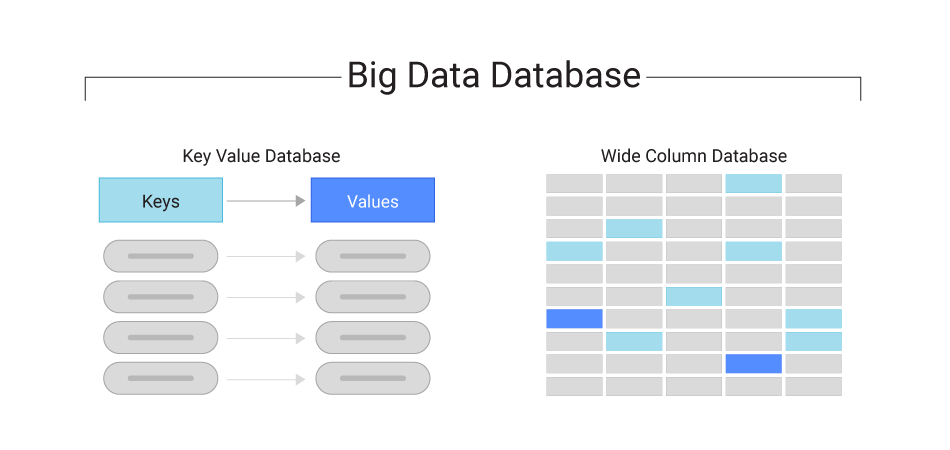Big Data Database FAQs
What Do Big Data Databases Do?
Big data NoSQL databases are commonly used to support demanding key-value and wide column database use cases at massive scale. For example, here are some examples of how they are used in various industries.
- Retail big data database use cases
- Product catalog: Support highly responsive product catalogs that keep customers engaged, driven by an adaptable data model.
- Customer 360: Enrich flexible customer profiles with event-driven demographic, contextual, and behavioral data.
- Shopping cart: Reduce abandonment with highly dynamic shopping carts that persist across channels and devices, while tracking purchasing behaviors for better customer intelligence.
- Recommendation engine: Leverage contextual and behavioral data to feed machine learning, growing sales by presenting relevant goods and offers.
- Loyalty program and promotions: Increase engagement and improve retention using real-time data to generate targeted discounts and incentives.
- Order fulfillment: Track order status across the supply chain, freight shipping, and last-mile delivery to minimize loss and improve customer satisfaction.
- Inventory management: Maintain optimal inventories to minimize “out of stock” notifications with globally distributed inventory management.
Social media big data database use cases:
- User profile: Manage personal attributes, preferences, tags, and history for hundreds of millions of interconnected users, with consistent, reliable real-time performance.
- Conversations: Deliver a superior user experience with real-time communications, faster connections and minimal lag as a result of low-latency database operations.
- Location tracking: Build responsive social apps and games that incorporate location streams from user devices.
- Media assets: Support high-performance storage of large binary objects, such as pictures, videos, and audio files.
AdTech and MarTech big data database use cases:
- Precision ad targeting: Serve ads at high volume based on impressions, revenue optimization, and campaign goals, rapidly determining the most engaging content for individual users and target audiences.
- Real-time analytics: Extract actionable insights from a sea of data to drive real-time decision-making.
- Machine learning: Run operational and analytics workloads at high velocity against the same datasets on the same infrastructure.
- User behavior and impressions: Capture and analyze clickstreams in real time to understand sentiment, spot trends, and optimize campaigns.
Related Solutions for Big Data
Big data databases might be part of a broader data platform that also includes relational databases, data warehouses, and data lakes.
What is a Data Warehouse?
A data warehouse is a central repository for storing and processing large quantities of old or new data. It is a big data database system that enables data to converge in a single place, and supports analytics, data mining, machine learning, and more.
A data warehouse must store structured data organized into schemas for later analysis. Data warehouses clean and sort data into predesigned schemas—a schema-on-write format.
Typically, data warehouses hold their data in relational databases. This requirement for structured data is the main difference between big data and relational databases generally and the place where the two topics converge.
Where data is unstructured and cannot work within a relational database model, the data lake exists.
What is a Data Lake?
Data lakes store unstructured or even unrelated data without a defined schema. In fact, data lakes can generate various real-time analytics, visualizations, and other tools with unstructured, ungroomed data. Because the data in data lakes need not be structured, it can accommodate massive quantities and varieties and is highly scalable. Data lakes are schema-on-read, meaning they analyze big data as they create schema. Data lakes can store data using cloud storage, a Hadoop cluster, or unstructured or non-relational NoSQL databases.
Choosing a Big Data Database
When making a big data database comparison consider factors like latency, throughput, the administrative burden, integrations/ecosystem, and the total cost of ownership.
Here’s a list of vendor-neutral guides that might be helpful as you select the best big data database for your team and projects.
How to Choose the Right Database for your Application (InfoWorld)
Martin Heller is a well-respected industry expert. His database selection guide outlines 12 key questions you should consider when evaluating and selecting a big data database:
- How much data do you expect to store when the application is mature?
- How many users do you expect to handle simultaneously at peak load?
- What availability, scalability, latency, throughput, and data consistency doe your application need?
- How often will your database schemas change?
- What is the geographic distribution of your user population?
- What is the natural “shape” of your data?
- Does your application need online transaction processing (OLTP), analytic queries (OLAP), or both?
- What ratio of reads to writes do you expect in production?
- Do you need geographic queries and/or full-text queries?
- What are your preferred programming languages?
- Do you have a budget? If so, will it cover licenses and support contracts?
- Are there legal restrictions on your data storage?
His article expands on each of those questions and explores their implications for your database evaluation.
Essential Reading for Choosing a NoSQL Database (ComputerWorld)
From CAP theorem, to database modeling, to engine comparison and benchmarking best practices, Matt Mombrea provides an overview of the various domains you should know about before you begin the big data database evaluation process.
Types of NoSQL Databases and Key Criteria for Choosing Them (TechTarget)
This article by Dan Sullivan is based on his book NoSQL for Mere Mortals. It introduces the four main types of big data NoSQL databases (key-value, document, wide column, and graph databases) and explains which applications are best suited for each of them.
Does ScyllaDB Offer Solutions for Big Data Database?
Yes. ScyllaDB is the best NoSQL database for big data. ScyllaDB offers an open source database solution, enterprise NoSQL solution, and cloud DBaaS that are incredibly fast and scalable. The ScyllaDB NoSQL database powers data-intensive applications with low latency and high availability around the world. Learn more here.


